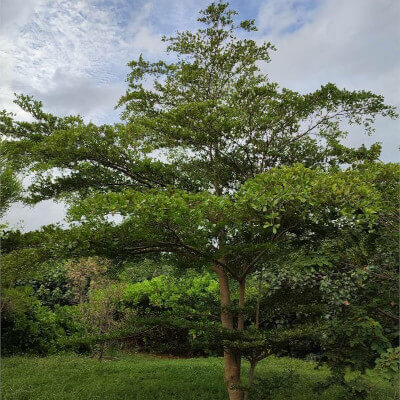
The Terminalia mantaly, more commonly known as the Madagascar Almond Tree, is an iconic tropical tree native to the island of Madagascar. Appreciated for its elegant form and distinctive tiered horizontal branches, it adds a touch of exotic beauty and provides shade to the spaces where it is planted. This evergreen or semi-evergreen tree, depending on the climate, reaches a height of 8 to 15 metres, making it an excellent choice for landscaping in tropical and subtropical regions. Its deep green, glossy oval leaves sometimes take on reddish hues during dry periods, further enhancing its visual appeal.
In the Au Bois Vert botanical garden, located near Ivato in Antananarivo, this tree holds a prominent place. Its umbrella-like silhouette and ability to withstand harsh climatic conditions make it a key element of local biodiversity and an attraction for visitors. Moreover, the Terminalia mantaly, or Madagascar Almond Tree, plays an important role in ecological regeneration, thanks to its deep roots that stabilise the soil and support the growth of microorganisms.
During its flowering season, typically between October and December, the Madagascar Almond Tree produces small, discreet white or greenish flowers. These flowers attract a variety of pollinating insects, further strengthening its role in the ecosystems where it is introduced. It also produces small winged nuts, which are carried by the wind, contributing to its natural reproduction.
Whether in a welcoming lodge like Au Bois Vert or near an open-air restaurant, this majestic tree offers unparalleled comfort by providing shade and enhancing the surrounding landscape.
Plant use
The Madagascar Almond Tree is much more than an ornamental tree. It stands out for its numerous practical and ecological uses. In rural areas of Madagascar, local populations often use its wood to make lightweight furniture and tools, thanks to its robustness and ease of working. Its leaves, rich in tannins, are also used in traditional remedies to treat various ailments, particularly inflammations and skin infections. At the Au Bois Vert botanical garden, Terminalia mantaly plays a major ecological role. It provides dense shade, making it ideal for creating relaxing spaces in establishments such as hotels and restaurants. Its thick foliage helps lower ambient temperatures and enhances visitor comfort. This tree is also used in the design of hedges or pathways, thanks to its structured growth habit, which gives a well-organised and harmonious appearance. The Madagascar Almond Tree also helps combat soil erosion, a common issue in tropical regions. In urban areas, it fits perfectly into reforestation and urban planning projects due to its low water requirements and adaptability to various soil types. In summary, Terminalia mantaly is not only a symbol of tropical beauty but also an ecological and practical asset for those looking to create sustainable and pleasant living spaces.
Key information
| Common name | Madagascar Almond Tree |
| Scientific name | Terminalia mantaly |
| Origin | Madagascar |
| Natural habitat | Tropical and subtropical regions, semi-arid zones |
| Life cycle | Perennial |
| Flowering period | October to December |


